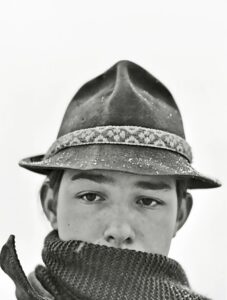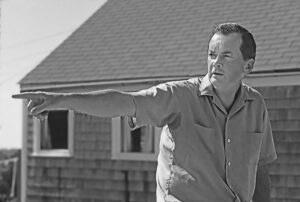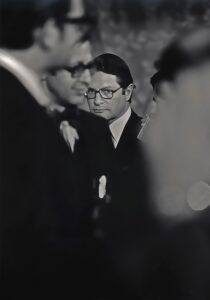If you were to flip through Andrew de Lory’s portrait photographs, you might come face to face with Prince Charles playing polo or Odetta, eyes closed, serenading an unseen crowd at the 1965 Newport Folk Festival. You might see a young Vietnamese woman frozen in a moment of arrival, the white of her traditional silk ào dài contrasting the muted grays of the sky, the rubble, and the U.S. Army transport vehicle that surround her.
Hundreds of such portraits — mostly in black and white but sometimes filtered with deep red or cerulean blue — compose de Lory’s oeuvre, which spans six decades, several continents, and his experience as a noncombatant photojournalist in the U.S. Army during the Vietnam War.
“I approached photography with the poet Yevgeny Yevtushenko’s attitude that no people are uninteresting and the idea that everyone had their own soul and honest moments to share,” says de Lory, 77, who grew up in Orleans and now lives there again.
De Lory has captured politicians, sailors, football stars, Orthodox Jews, and a host of figures from the Vietnam War era in unguarded moments: singing, laughing, embracing, staring. Few portrait subjects meet the camera’s eye directly, but when they do, it’s like having the wind knocked out of you.
Thirty-five of his portraits were recently displayed in a retrospective exhibition, “Portraits — Local and Global,” at Snow Library in Orleans. De Lory hopes the exhibition will become an annual event. In the meantime, he continues to photograph subjects on the Outer Cape while compiling a book of back stories to go with his images.
His photographs powerfully evoke the curiosity and generosity of artistic vision that originated for him with a Kodak Brownie Hawkeye camera and early mentorship from the artist Vernon Smith and from Jim Owens, an art teacher at Nauset High School.
“It was the first time I’d seen photographs as art,” says de Lory, remembering a day when Owens, also a photographer, brought a stack of his own photographs to class.
After that, de Lory experimented, taking photos of friends and acquaintances with a 4×5 large-format viewfinder camera. One of the results is a portrait of the artist Helen Miranda Wilson, shot in Wellfleet in 1963 under a lilac.
“I think she was 15 at the time,” he says. “We met through mutual friends and all of us used to get together and swim in the local ponds. What you see in the print is how I composed it in the viewfinder.”

That approach to composing — capturing the entirety of the moment of encounter without later cropping — runs through de Lory’s work and underscores his representational aspirations.
“It is almost an intuitive process,” he says. “I’m looking for honest moments in people’s faces and composing well in the context of the setting.”
Such a photograph captures de Lory’s friend and fellow “art nerd” Dan Joy, the grandson of Vernon Smith, in 1965, the year they graduated from Nauset High. Flakes of ice and snow dust a banded leather cap as Joy’s eyes lock on something to the left and slightly outside the frame. De Lory notes that, almost 60 years later, Joy still has an impressive hat collection.

In those early days, de Lory also photographed older, more established Cape Cod characters like the author and naturalist John Hay, who cofounded the Cape Cod Museum of Natural History, which de Lory visited as a child.
“There were guided field walks in marshes, at shoreline, in tide pools, and birdwatching,” says de Lory. “It was then, with Hay’s inspired teaching, that I began to have a reverence for nature and all living things.”
Influenced by Hay and his 1963 book The Great Beach and by Henry David Thoreau, de Lory walked from Eastham to Provincetown as a teenager. “I think we really started to bond after I made that walk,” he says. Hay wrote a recommendation letter for de Lory to supplement his application for conscientious objector status, which kept him out of combat in Vietnam but not out of the war.

Following nine months there, de Lory lived in London for several years. That’s how his portrait of Elliot Richardson came about. At the time, in 1975, Richardson was the U.S. ambassador to the United Kingdom for the Gerald Ford administration following several positions in — and a highly publicized resignation from — Richard Nixon’s cabinet.
To escape the intensity of Washington, D.C., Richardson came to stay at a house in Eastham. This Cape connection inspired a journalist friend of de Lory’s in Orleans to come to London to do a story — and he looped de Lory in on it. They visited the ambassador’s residence, Winfield House, and de Lory asked to stay and photograph the reception that followed. He kept an eye out for Richardson and finally captured him.

“It was a rare moment, because for a few seconds he was kind of isolated in his own space, not interacting with anybody else,” says de Lory. “Everything came together — the composition, the expression, the lighting — and then he disappeared into the crowd.”



